Dalitz plot analysis of $B_s^0 \rightarrow \overline{D}^0 K^- \pi^+$ decays
[to restricted-access page]Information
LHCb-PAPER-2014-036
CERN-PH-EP-2014-184
arXiv:1407.7712 [PDF]
(Submitted on 29 Jul 2014)
Phys. Rev. D90 (2014) 072003
Inspire 1308737
Tools
Abstract
The resonant substructure of $B_s^0 \rightarrow \bar{D}^0 K^- \pi^+$ decays is studied with the Dalitz plot analysis technique. The study is based on a data sample corresponding to an integrated luminosity of $3.0 {\rm fb}^{-1}$ of $pp$ collision data recorded by LHCb. A structure at $m(\bar{D}^0 K^-) \approx 2.86 {\rm GeV}/c^2$ is found to be an admixture of spin-1 and spin-3 resonances. The masses and widths of these states and of the $D^*_{s2}(2573)^-$ meson are measured, as are the complex amplitudes and fit fractions for all the $\bar{D}^0 K^-$ and $K^-\pi^+$ components included in the amplitude model. In addition, the $D^*_{s2}(2573)^-$ resonance is confirmed to be spin-2.
Figures and captions
|
Distribution of $\overline{ D }{} {}^0$ candidate invariant mass for $ B ^0_ s $ candidates in the signal region defined in Sec. 4. Here the selection criteria have been modified to avoid biasing the distribution: the $\overline{ D }{} {}^0 $ candidate invariant mass requirement has been removed, and the $\chi^2 $ of the kinematic fit is calculated without applying the $\overline{ D }{} {}^0 $ mass constraint. |
Fig1.pdf [17 KiB] HiDef png [102 KiB] Thumbnail [56 KiB] *.C file |

|
|
Result of the fit to the $ B ^0_ s \rightarrow \overline{ D }{} {}^0 K ^- \pi ^+ $ candidates invariant mass distribution shown with (a) linear and (b) logarithmic $y$-axis scales. Data points are shown in black, the total fit as a solid blue line and the components as detailed in the legend. |
Fig2a.pdf [30 KiB] HiDef png [312 KiB] Thumbnail [254 KiB] *.C file |

|
|
Fig2b.pdf [28 KiB] HiDef png [254 KiB] Thumbnail [201 KiB] *.C file |

|
|
|
Distribution of $ B ^0_ s \rightarrow \overline{ D }{} {}^0 K ^- \pi ^+ $ candidates in the signal region over (a) the Dalitz plot and (b) the square Dalitz plot defined in Eq. (19). The effect of the $ D ^0$ veto can be seen as an unpopulated horizontal (curved) band in the (square) Dalitz plot. |
Fig3a.pdf [159 KiB] HiDef png [286 KiB] Thumbnail [135 KiB] *.C file |

|
|
Fig3b.pdf [160 KiB] HiDef png [388 KiB] Thumbnail [205 KiB] *.C file |

|
|
|
SDP distributions of the background contributions from (a) combinatorial, (b) $\overline{\Lambda} {}^0_ b \rightarrow \overline{ D }{} {}^{(*)0} \overline p \pi ^+ $ and (c) $ B ^0 \rightarrow \overline{ D }{} {}^{(*)0} \pi ^+ \pi ^- $ backgrounds. |
Fig4a.pdf [19 KiB] HiDef png [197 KiB] Thumbnail [168 KiB] *.C file |

|
|
Fig4b.pdf [18 KiB] HiDef png [188 KiB] Thumbnail [164 KiB] *.C file |
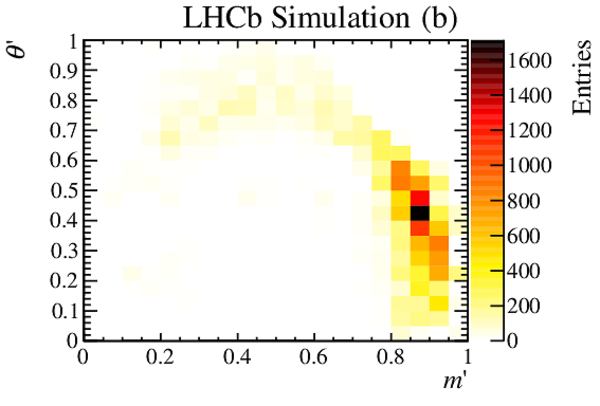
|
|
|
Fig4c.pdf [19 KiB] HiDef png [209 KiB] Thumbnail [181 KiB] *.C file |

|
|
|
Signal efficiency across the SDP for (a) events triggered by signal decay products and (b) the rest of the event. The relative uncertainty at each point is typically $5 \%$. The effect of the $ D ^0$ veto can be seen as a curved band running across the SDP, while the $ D ^*$ veto appears in the bottom left corner of the SDP. |
Fig5a.pdf [692 KiB] HiDef png [2 MiB] Thumbnail [599 KiB] *.C file |

|
|
Fig5b.pdf [677 KiB] HiDef png [1 MiB] Thumbnail [579 KiB] *.C file |

|
|
|
Distribution of the pull between data and the fit result as a function of SDP position. |
Fig6.pdf [27 KiB] HiDef png [174 KiB] Thumbnail [152 KiB] *.C file |

|
|
Projections of the data and the Dalitz plot fit result onto (a) $m( K ^- \pi ^+ )$, (c) $m(\overline{ D }{} {}^0 K ^- )$ and (e) $m(\overline{ D }{} {}^0 \pi ^+ )$, with the same projections shown with a logarithmic $y$-axis scale in (b), (d) and (f), respectively. The components are as described in the legend (small background components are not shown). |
Fig7a.pdf [40 KiB] HiDef png [260 KiB] Thumbnail [182 KiB] *.C file |

|
|
Fig7b.pdf [25 KiB] HiDef png [572 KiB] Thumbnail [351 KiB] *.C file |

|
|
|
Fig7c.pdf [37 KiB] HiDef png [250 KiB] Thumbnail [189 KiB] *.C file |
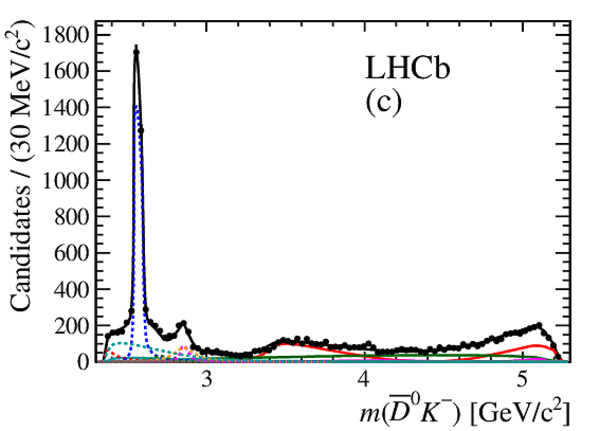
|
|
|
Fig7d.pdf [25 KiB] HiDef png [512 KiB] Thumbnail [326 KiB] *.C file |

|
|
|
Fig7e.pdf [42 KiB] HiDef png [348 KiB] Thumbnail [263 KiB] *.C file |

|
|
|
Fig7f.pdf [26 KiB] HiDef png [546 KiB] Thumbnail [340 KiB] *.C file |
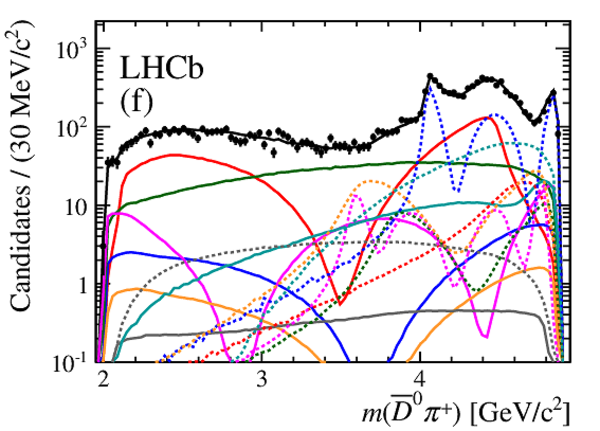
|
|
|
Fig7leg.pdf [13 KiB] HiDef png [102 KiB] Thumbnail [92 KiB] *.C file |

|
|
|
Projections of the data and the Dalitz plot fit result onto (a) $m( K ^- \pi ^+ )$ in the range $0.5$--$1.8 {\mathrm{ Ge V /}c^2} $, (b) $m(\overline{ D }{} {}^0 K ^- )$ between $2.2 {\mathrm{ Ge V /}c^2} $ and $3.2 {\mathrm{ Ge V /}c^2} $, (c) $m(\overline{ D }{} {}^0 K ^- )$ around the $D^{*}_{s2}(2573)^-$ resonance and (d) the $D^{*}_{sJ}(2860)^-$ region. Discrepancies between the data and the model are discussed at the end of Sec. 7. The components are as described in the legend for Fig 7. |
Fig8a.pdf [38 KiB] HiDef png [248 KiB] Thumbnail [183 KiB] *.C file |

|
|
Fig8b.pdf [47 KiB] HiDef png [293 KiB] Thumbnail [221 KiB] *.C file |

|
|
|
Fig8c.pdf [82 KiB] HiDef png [275 KiB] Thumbnail [225 KiB] *.C file |

|
|
|
Fig8d.pdf [43 KiB] HiDef png [347 KiB] Thumbnail [268 KiB] *.C file |

|
|
|
Projections of the data and the Dalitz plot fit result onto the cosine of the helicity angle of the $ K ^- \pi ^+ $ system, $\cos\theta( K ^- \pi ^+ )$, for $m( K ^- \pi ^+ )$ slices of (a) $0$--$0.8 {\mathrm{ Ge V /}c^2} $, (b) $0.8$--$1.0 {\mathrm{ Ge V /}c^2} $, (c) $1.0$--$1.3 {\mathrm{ Ge V /}c^2} $ and (d) $1.4$--$1.5 {\mathrm{ Ge V /}c^2} $. The data are shown as black points, the total fit result as a solid blue curve, and the small contributions from $ B ^0 \rightarrow \overline{ D }{} {}^{(*)0} \pi ^+ \pi ^- $, $\overline{\Lambda} {}^0_ b \rightarrow \overline{ D }{} {}^{(*)0} \overline p \pi ^+ $ and combinatorial background shown as green, black and red curves, respectively. |
Fig9a.pdf [18 KiB] HiDef png [223 KiB] Thumbnail [191 KiB] *.C file |

|
|
Fig9b.pdf [18 KiB] HiDef png [211 KiB] Thumbnail [183 KiB] *.C file |

|
|
|
Fig9c.pdf [18 KiB] HiDef png [214 KiB] Thumbnail [184 KiB] *.C file |

|
|
|
Fig9d.pdf [18 KiB] HiDef png [210 KiB] Thumbnail [183 KiB] *.C file |

|
|
|
Projections of the data and the Dalitz plot fit result onto the cosine of the helicity angle of the $\overline{ D }{} {}^0 K ^- $ system, $\cos\theta(\overline{ D }{} {}^0 K ^- )$, for $m(\overline{ D }{} {}^0 K ^- )$ slices of (a) $0$--$2.49 {\mathrm{ Ge V /}c^2} $, (b) $2.49$--$2.65 {\mathrm{ Ge V /}c^2} $, (c) $2.65$--$2.77 {\mathrm{ Ge V /}c^2} $ and (d) $2.77$--$2.91 {\mathrm{ Ge V /}c^2} $. The data are shown as black points, the total fit result as a solid blue curve, and the small contributions from $ B ^0 \rightarrow \overline{ D }{} {}^{(*)0} \pi ^+ \pi ^- $, $\overline{\Lambda} {}^0_ b \rightarrow \overline{ D }{} {}^{(*)0} \overline p \pi ^+ $ and combinatorial background shown as green, black and red curves, respectively. |
Fig10a.pdf [18 KiB] HiDef png [227 KiB] Thumbnail [205 KiB] *.C file |

|
|
Fig10b.pdf [18 KiB] HiDef png [202 KiB] Thumbnail [177 KiB] *.C file |

|
|
|
Fig10c.pdf [18 KiB] HiDef png [224 KiB] Thumbnail [198 KiB] *.C file |

|
|
|
Fig10d.pdf [18 KiB] HiDef png [246 KiB] Thumbnail [202 KiB] *.C file |

|
|
|
Projections of the data and Dalitz plot fit results with alternative models onto the cosine of the helicity angle of the $\overline{ D }{} {}^0 K ^- $ system, $\cos\theta(\overline{ D }{} {}^0 K ^- )$, for $2.49 < m(\overline{ D }{} {}^0 K ^- ) < 2.65 {\mathrm{ Ge V /}c^2} $. The data are shown as black points, the result of the baseline fit with a spin-2 resonance is given as a solid blue curve, and the result of the fit from the best model with a spin-0 resonance is shown as a dashed red line. |
Fig11.pdf [21 KiB] HiDef png [173 KiB] Thumbnail [153 KiB] *.C file |

|
|
Legendre moments up to order 7 calculated as a function of $m(\overline{ D }{} {}^0 K ^- )$ for data (black data points) and the fit result (solid blue curve). |
Fig12a.pdf [15 KiB] HiDef png [171 KiB] Thumbnail [153 KiB] *.C file |

|
|
Fig12b.pdf [16 KiB] HiDef png [177 KiB] Thumbnail [169 KiB] *.C file |
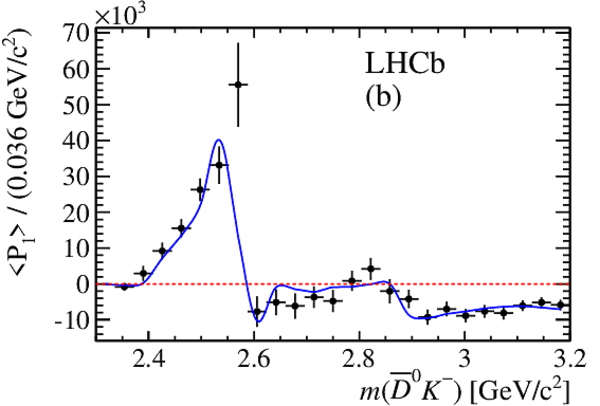
|
|
|
Fig12c.pdf [16 KiB] HiDef png [181 KiB] Thumbnail [159 KiB] *.C file |

|
|
|
Fig12d.pdf [16 KiB] HiDef png [166 KiB] Thumbnail [156 KiB] *.C file |

|
|
|
Fig12e.pdf [16 KiB] HiDef png [184 KiB] Thumbnail [165 KiB] *.C file |
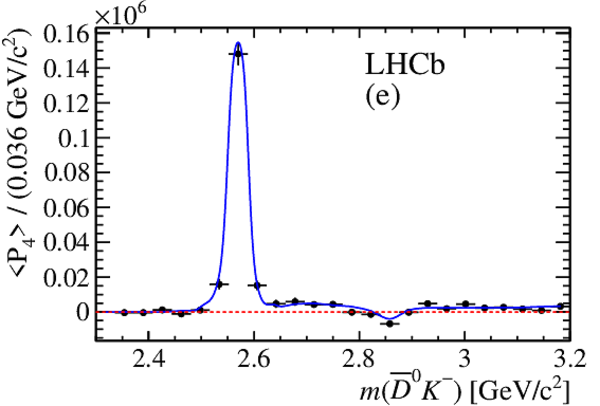
|
|
|
Fig12f.pdf [16 KiB] HiDef png [156 KiB] Thumbnail [152 KiB] *.C file |

|
|
|
Fig12g.pdf [16 KiB] HiDef png [157 KiB] Thumbnail [154 KiB] *.C file |

|
|
|
Fig12h.pdf [16 KiB] HiDef png [163 KiB] Thumbnail [150 KiB] *.C file |
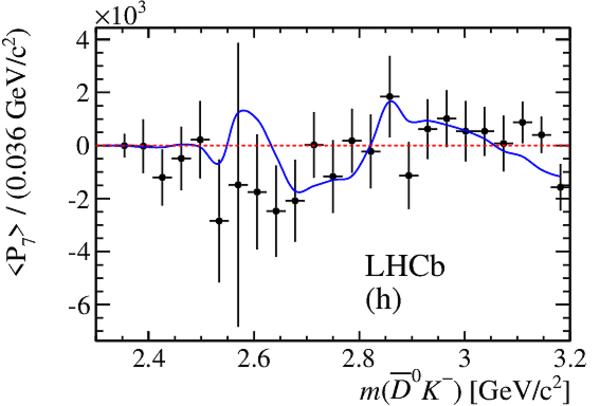
|
|
|
Legendre moments up to order 7 calculated as a function of $m( K ^- \pi ^+ )$ for data (black data points) and the fit result (solid blue curve). |
Fig13a.pdf [16 KiB] HiDef png [183 KiB] Thumbnail [169 KiB] *.C file |

|
|
Fig13b.pdf [16 KiB] HiDef png [172 KiB] Thumbnail [151 KiB] *.C file |
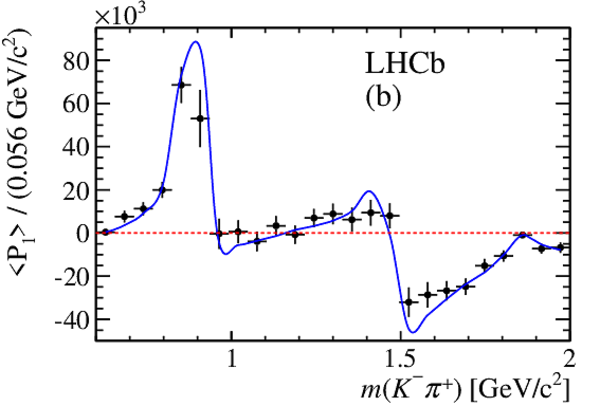
|
|
|
Fig13c.pdf [16 KiB] HiDef png [189 KiB] Thumbnail [174 KiB] *.C file |

|
|
|
Fig13d.pdf [16 KiB] HiDef png [169 KiB] Thumbnail [153 KiB] *.C file |

|
|
|
Fig13e.pdf [16 KiB] HiDef png [163 KiB] Thumbnail [154 KiB] *.C file |

|
|
|
Fig13f.pdf [16 KiB] HiDef png [162 KiB] Thumbnail [147 KiB] *.C file |

|
|
|
Fig13g.pdf [16 KiB] HiDef png [163 KiB] Thumbnail [146 KiB] *.C file |

|
|
|
Fig13h.pdf [16 KiB] HiDef png [175 KiB] Thumbnail [163 KiB] *.C file |

|
|
|
Projections of the data and Dalitz plot fit results with alternative models onto the cosine of the helicity angle of the $\overline{ D }{} {}^0 K ^- $ system, $\cos\theta(\overline{ D }{} {}^0 K ^- )$, for $2.77 < m(\overline{ D }{} {}^0 K ^- ) < 2.91 {\mathrm{ Ge V /}c^2} $. The data are shown as black points, the result of the baseline fit with both spin-1 and spin-3 resonances is given as a solid blue curve, and results of fits from the best models with only either a spin-1 or a spin-3 resonance are shown as dashed red and dotted green lines, respectively. The dip at $\cos\theta(\overline{ D }{} {}^0 K ^- ) \approx -0.6$ is due to the $\overline{ D }{} {}^0 $ veto. Comparison of the data and the different fit results in the 50 bins of this projection gives $\chi^2 $ values of 47.3, 214.0 and 150.0 for the default, spin-1 only and spin-3 only models, respectively. |
Fig14.pdf [23 KiB] HiDef png [251 KiB] Thumbnail [208 KiB] *.C file |

|
|
Fits of $\chi^2$ functions to the $2\Delta{\rm NLL}$ distributions obtained from fits to pseudoexperiments generated with (left) no $D_{s1}^*(2860)^-$ and (right) no $D_{s3}^*(2860)^-$ component. The corresponding $2\Delta{\rm NLL}$ values observed in data are 273 and 314, respectively (see Table 7). |
Fig15a.pdf [15 KiB] HiDef png [115 KiB] Thumbnail [92 KiB] *.C file |

|
|
Fig15b.pdf [15 KiB] HiDef png [112 KiB] Thumbnail [91 KiB] *.C file |

|
|
|
Animated gif made out of all figures. |
PAPER-2014-036.gif Thumbnail |

|
Tables and captions
|
Excited charm-strange states above the $D_{s2}^*(2573)^-$ seen in $ D ^{(*)} K $ spectra by BaBar [5] in $ e ^+ e ^-$ collisions and by LHCb [6] in $pp$ collisions. Units of $ {\mathrm{ Me V /}c^2} $ are implied. The first source of uncertainty is statistical and the second is systematic. |
Table_1.pdf [55 KiB] HiDef png [65 KiB] Thumbnail [31 KiB] tex code |

|
|
Results of the $ B ^0_ s \rightarrow \overline{ D }{} {}^0 K ^- \pi ^+ $ candidate invariant mass fit. Uncertainties are statistical only. |
Table_2.pdf [71 KiB] HiDef png [118 KiB] Thumbnail [57 KiB] tex code |

|
|
Yields of the fit components within the signal region used for the Dalitz plot analysis. |
Table_3.pdf [53 KiB] HiDef png [110 KiB] Thumbnail [50 KiB] tex code |

|
|
Contributions to the fit model. Resonances labelled with subscript $v$ are virtual. Parameters and uncertainties are taken from Ref. [3] except where indicated otherwise. Details of these models are given in Sec. 5. |
Table_4.pdf [57 KiB] HiDef png [134 KiB] Thumbnail [61 KiB] tex code |

|
|
Fit fractions and complex coefficients determined from the Dalitz plot fit. Uncertainties are statistical only and are obtained as described in the text. |
Table_5.pdf [56 KiB] HiDef png [140 KiB] Thumbnail [65 KiB] tex code |

|
|
Resonance parameters of the $D^{*}_{s2}(2573)^-$, $D^{*}_{s1}(2860)^-$ and $D^{*}_{s3}(2860)^-$ states from the Dalitz plot fit (statistical uncertainties only). |
Table_6.pdf [51 KiB] HiDef png [62 KiB] Thumbnail [29 KiB] tex code |

|
|
Changes in NLL from fits with different hypotheses for the state(s) at $m(\overline{ D }{} {}^0 K ^- )=2860 {\mathrm{ Me V /}c^2} $. Units of $ {\mathrm{ Me V /}c^2} $ are implied for the masses and widths. When two pairs of mass and width values are given, the first corresponds to the lower spin state. Values marked * are discussed further in the text. There are two entries for spin-2 because two solutions were found. |
Table_7.pdf [24 KiB] HiDef png [83 KiB] Thumbnail [39 KiB] tex code |

|
|
Experimental systematic uncertainties on the fit fractions and complex amplitudes. |
Table_8.pdf [48 KiB] HiDef png [92 KiB] Thumbnail [41 KiB] tex code |

|
|
Breakdown of experimental systematic uncertainties on the fit fractions (%). The columns give the contributions from the different sources described in the text. |
Table_9.pdf [49 KiB] HiDef png [125 KiB] Thumbnail [54 KiB] tex code |

|
|
Breakdown of experimental systematic uncertainties on the masses and widths. Units of $ {\mathrm{ Me V /}c^2}$ are implied. The columns give the contributions from the different sources described in the text. |
Table_10.pdf [48 KiB] HiDef png [75 KiB] Thumbnail [32 KiB] tex code |

|
|
Model uncertainties on the fit fractions and complex amplitudes. |
Table_11.pdf [48 KiB] HiDef png [91 KiB] Thumbnail [40 KiB] tex code |

|
|
Breakdown of model uncertainties on the fit fractions (%). The columns give the contributions from the different sources described in the text. |
Table_12.pdf [48 KiB] HiDef png [139 KiB] Thumbnail [63 KiB] tex code |

|
|
Breakdown of model uncertainties on the masses and widths. Units of $ {\mathrm{ Me V /}c^2}$ are implied. The columns give the contributions from the different sources described in the text. |
Table_13.pdf [46 KiB] HiDef png [98 KiB] Thumbnail [46 KiB] tex code |

|
|
Results for the complex amplitudes and their uncertainties. The three quoted errors are statistical, experimental systematic and model uncertainties, respectively. The central values and statistical uncertainties are as reported in Table 5, while the experimental and model systematic uncertainties are as reported in Tables 8 and 11. |
Table_14.pdf [55 KiB] HiDef png [163 KiB] Thumbnail [67 KiB] tex code |

|
|
Results for the fit fractions and their uncertainties (%). The three quoted errors are statistical, experimental systematic and model uncertainties, respectively. Upper limits at both 90 % and 95 % confidence level (CL) are given for components that are not significant. The central values and statistical uncertainties are as reported in Table 5, while the experimental and model systematic uncertainties are as reported in Tables 8 and 11. |
Table_15.pdf [54 KiB] HiDef png [151 KiB] Thumbnail [79 KiB] tex code |

|
|
Results for the product branching fractions (top) ${\cal B}( B ^0_ s \rightarrow \overline{ D }{} {}^0 \overline{ K }{} {}^{*0} )\times{\cal B}(\overline{ K }{} {}^{*0} \rightarrow K ^- \pi ^+ )$ and (bottom) ${\cal B}( B ^0_ s \rightarrow D_s^{*-}\pi ^+ )\times{\cal B}(D_s^{*-} \rightarrow \overline{ D }{} {}^0 K ^- )$, for each $\overline{ K }{} {}^{*0} $ and $D_s^{*-}$ resonance. For the $\overline{ K }{} {}^{*0} $ resonances, where ${\cal B}(\overline{ K }{} {}^{*0} \rightarrow K ^- \pi ^+ )$ is known [3], the $ B ^0_ s $ decay branching fraction is also given. The four quoted uncertainties are statistical, experimental systematic, model and PDG uncertainties, respectively. Upper limits are given at 90 % (95 %) confidence level. |
Table_16.pdf [54 KiB] HiDef png [129 KiB] Thumbnail [64 KiB] tex code |

|
|
Interference fit fractions (%) from the nominal Dalitz plot fit. The amplitudes are: ($A_{0}$) $\overline{ K }{} {}^* (892)^{0}$, ($A_{1}$) $\overline{ K }{} {}^* (1410)^{0}$, ($A_{2}$) $\overline{ K }{} {}^*_0 (1430)^{0}$, ($A_{3}$) LASS nonresonant, ($A_{4}$) $\overline{ K }{} {}^*_2 (1430)^{0}$, ($A_{5}$) $\overline{ K }{} {}^* (1680)^{0}$, ($A_{6}$) $\overline{ K }{} {}^*_0 (1950)^{0}$, ($A_{7}$) $D^{*-}_{s v}$, ($A_{8}$) $D^{*}_{s0 v}(2317)^-$, ($A_{9}$) $D^{*}_{s2}(2573)^-$, ($A_{10}$) $D^{*}_{s1}(2700)^-$, ($A_{11}$) $D^{*}_{s3}(2860)^-$, ($A_{12}$) $D^{*}_{s1}(2860)^-$, ($A_{13}$) $B^{*+}_{v}$, ($A_{14}$) Nonresonant. The diagonal elements correspond to the fit fractions shown in Table 5. |
Table_17.pdf [34 KiB] HiDef png [60 KiB] Thumbnail [28 KiB] tex code |

|
|
Absolute statistical uncertainties on the interference fit fractions (%) from the Dalitz plot fit. The amplitudes are: ($A_{0}$) $\overline{ K }{} {}^* (892)^{0}$, ($A_{1}$) $\overline{ K }{} {}^* (1410)^{0}$, ($A_{2}$) $\overline{ K }{} {}^*_0 (1430)^{0}$, ($A_{3}$) LASS nonresonant, ($A_{4}$) $\overline{ K }{} {}^*_2 (1430)^{0}$, ($A_{5}$) $\overline{ K }{} {}^* (1680)^{0}$, ($A_{6}$) $\overline{ K }{} {}^*_0 (1950)^{0}$, ($A_{7}$) $D^{*-}_{s v}$, ($A_{8}$) $D^{*}_{s0 v}(2317)^-$, ($A_{9}$) $D^{*}_{s2}(2573)^-$, ($A_{10}$) $D^{*}_{s1}(2700)^-$, ($A_{11}$) $D^{*}_{s3}(2860)^-$, ($A_{12}$) $D^{*}_{s1}(2860)^-$, ($A_{13}$) $B^{*+}_{v}$, ($A_{14}$) Nonresonant. The diagonal elements correspond to the statistical uncertainties on the fit fractions shown in Table 5. |
Table_18.pdf [28 KiB] HiDef png [79 KiB] Thumbnail [35 KiB] tex code |

|
|
Absolute experimental systematic uncertainties on the interference fit fractions (%). The amplitudes are: ($A_{0}$) $\overline{ K }{} {}^* (892)^{0}$, ($A_{1}$) $\overline{ K }{} {}^* (1410)^{0}$, ($A_{2}$) $\overline{ K }{} {}^*_0 (1430)^{0}$, ($A_{3}$) LASS nonresonant, ($A_{4}$) $\overline{ K }{} {}^*_2 (1430)^{0}$, ($A_{5}$) $\overline{ K }{} {}^* (1680)^{0}$, ($A_{6}$) $\overline{ K }{} {}^*_0 (1950)^{0}$, ($A_{7}$) $D^{*-}_{s v}$, ($A_{8}$) $D^{*}_{s0 v}(2317)^-$, ($A_{9}$) $D^{*}_{s2}(2573)^-$, ($A_{10}$) $D^{*}_{s1}(2700)^-$, ($A_{11}$) $D^{*}_{s3}(2860)^-$, ($A_{12}$) $D^{*}_{s1}(2860)^-$, ($A_{13}$) $B^{*+}_{v}$, ($A_{14}$) Nonresonant. The diagonal elements correspond to the experimental systematic uncertainties on the fit fractions shown in Table 8. |
Table_19.pdf [28 KiB] HiDef png [89 KiB] Thumbnail [39 KiB] tex code |

|
|
Absolute model uncertainties on the interference fit fractions (%). The amplitudes are: ($A_{0}$) $\overline{ K }{} {}^* (892)^{0}$, ($A_{1}$) $\overline{ K }{} {}^* (1410)^{0}$, ($A_{2}$) $\overline{ K }{} {}^*_0 (1430)^{0}$, ($A_{3}$) LASS nonresonant, ($A_{4}$) $\overline{ K }{} {}^*_2 (1430)^{0}$, ($A_{5}$) $\overline{ K }{} {}^* (1680)^{0}$, ($A_{6}$) $\overline{ K }{} {}^*_0 (1950)^{0}$, ($A_{7}$) $D^{*-}_{s v}$, ($A_{8}$) $D^{*}_{s0 v}(2317)^-$, ($A_{9}$) $D^{*}_{s2}(2573)^-$, ($A_{10}$) $D^{*}_{s1}(2700)^-$, ($A_{11}$) $D^{*}_{s3}(2860)^-$, ($A_{12}$) $D^{*}_{s1}(2860)^-$, ($A_{13}$) $B^{*+}_{v}$, ($A_{14}$) Nonresonant. The diagonal elements correspond to the model uncertainties on the fit fractions shown in Table 11. |
Table_20.pdf [28 KiB] HiDef png [89 KiB] Thumbnail [39 KiB] tex code |

|
Created on 03 May 2024.
